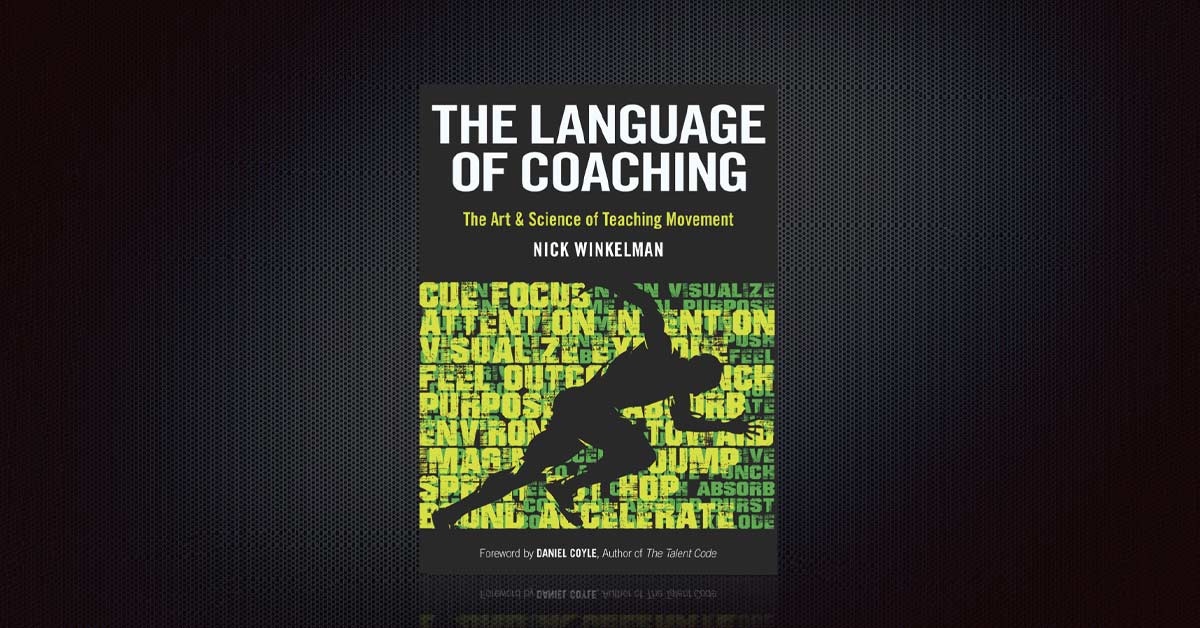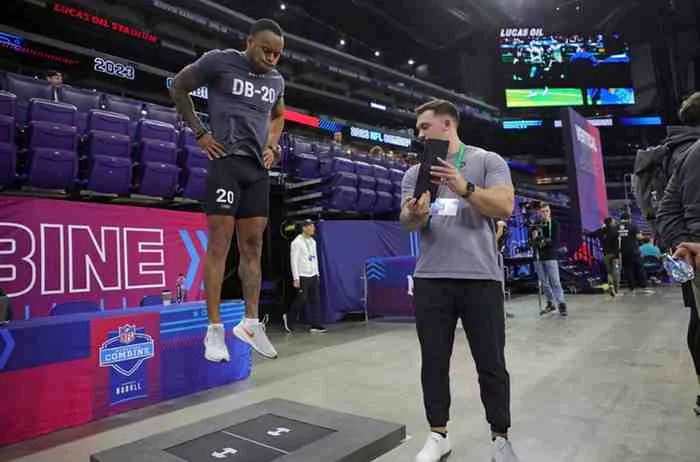If you are involved in a coach-athlete, teacher-student, trainer-client, and/or therapist-patient pairing and want to improve your communication and learn to incorporate more effective language to effect behavior change, then you should read Nick Winkelman’s The Language of Coaching: The Art & Science of Teaching Movement.
The Book at a Glance
Although sitting at a little more than 300 pages long, the engaging storytelling, frequent imagery, and practical exercises ensure the book is an engrossing read. Nick deftly weaves the story of his own coaching and communication enlightenment journey around the journey the reader takes through the book.
The story is told in three acts: Learn, Coach, Cue. The reader is first introduced to the science behind learning, attention, and memory. This is followed by explanations of how what we say influences movements and behaviors, culminating in what to say (and when to say it) to your charges.
Why I Recommend This Book
From the scientific research at its foundation to the practical, real-world coaching skills and experience distilled from decades of research and experience, The Language of Coaching is one of a few emerging resources in the coaching field that assists practitioners in incorporating the science underpinning communication into the art of coaching. The book is well-written, professionally produced, and an enjoyable read. (Additionally, it has a very reasonable retail price.)
The Language of Coaching is one of a few emerging resources in the coaching field that assists practitioners in incorporating the science underpinning communication into the art of coaching. Share on XMy first major introduction to Nick Winkelman was at EXOS in Phoenix, when attending an ALTIS event. I was previously aware of Nick via social media, but this was the first opportunity to interact with him in person. He was one of the guest presenters for ALTIS, delivering his talk on “What We Say Matters.” And I believe it is fair to say that The Language of Coaching: The Art and Science of Teaching Movement is the result of the evolution of Nick’s thoughts and concepts in this area since that presentation.
It is also probably fair to say that the coach involved in running the perennially successful National Football League (NFL) Combine preparation program at EXOS, and who contributed to the renaissance of the Irish Rugby Football team in recent years (including a win against the All Blacks, the “winningest” team in world sports), knows a thing or two about coaching. The breadth and depth of industry leaders lending their support and endorsements in the opening pages of the book is testament to the quality within.
In a webinar series to accompany the book, Nick explained that he aimed for the book to have the narrative quality of fiction in order to better engage the reader. One simple, obvious, but effective, method of doing this is beginning each chapter with an anecdote from his own journey. When I read and considered the implications of the first of these stories, I realized that it highlighted something else that Nick and the organizations he has guided do very well, but which is not ubiquitous in the S&C field: the application of deliberate and honest self-reflection. While successful and progressive organizations do this well and do it often, it can be completely absent within many environments unless there are people there willing to drive it. It may not have been one of the main learning points or goals of Nick’s book, but the importance of reflective practice is often overlooked and underutilized.
Nick discusses how the language we use and the analogies we provide must be meaningful and relatable to the athletes. Again, Nick parallels these pillars of coaching communication in the design of this book and the weaving in of his story with pop culture references and analogies from action movie stars to adult cartoons and music. Sprinkling the text with these universal entertainment references makes for a far more engaging read than the average coaching or science textbook.
I can encapsulate the main focus and value of this manual with a line from the preface: “As coaches we are far more comfortable talking about what we do than how we do it.” With The Language of Coaching, Nick Winkelman aims to teach coaches to wield our words with the same care and accuracy with which a surgeon operates.
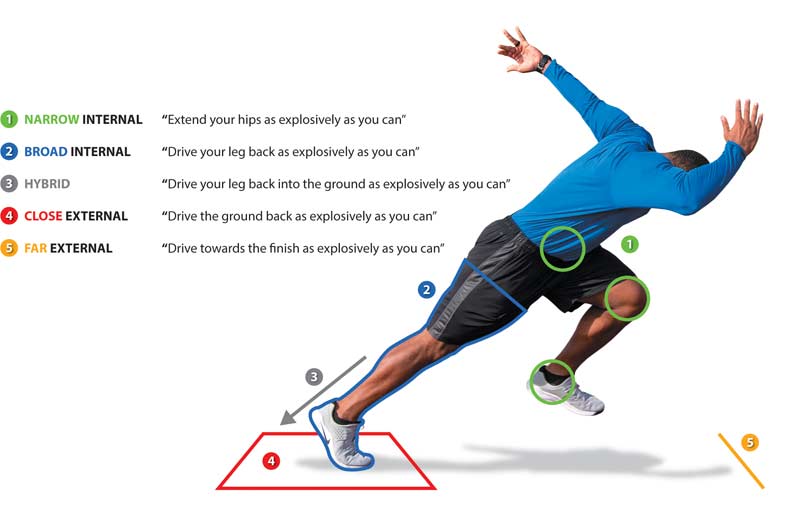
At its heart, this is a very simple book. Nick identifies a major problem in coaching today: while every graduate coming out of a university program understands that the role of the coach is to effect change in athletes, many enter the job market without the experience and expertise of how to communicate this to the athletes in an impactful way. Nick identifies the problem, clearly outlines the reason it is a problem, and provides an effective solution (actually a series of compounding practical solutions). It is this simple approach to a major problem that makes this book so important.
For what is largely a practical profession, and for this particular practical problem, the answer cannot be found merely by studying the research. However, understanding the theoretical knowledge underpinning these coaching behaviors is essential to understanding the problem and developing practical solutions. It is in this final area that The Language of Coaching shines compared to many other coaching resources.
Nick’s manual guides the reader in how to actually put these strategies into practice. While reading The Language of Coaching, I came across this tweet that proposes the same argument. To read and understand is not enough; we must also apply, reflect upon, and refine this practical application:
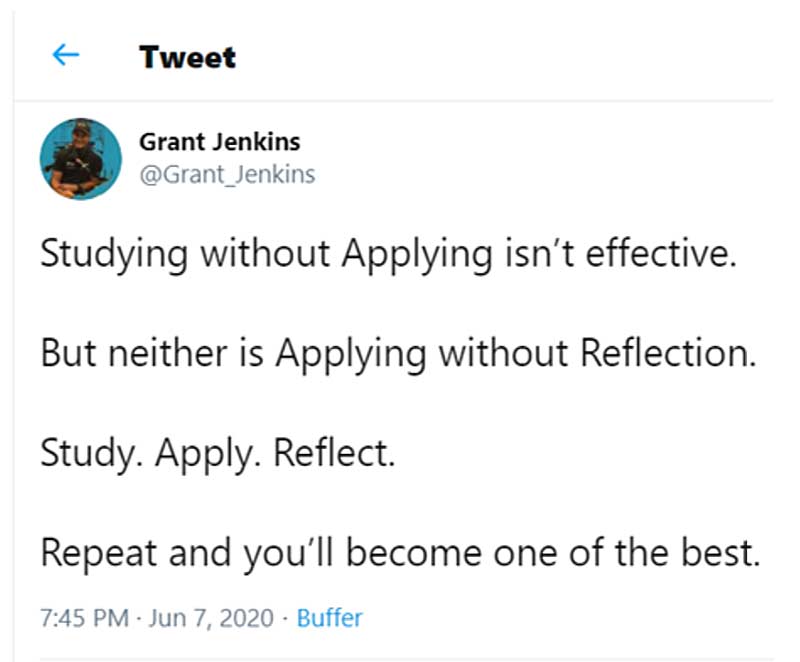
In addition to incorporating many practical, real-world examples for improving cueing and coaching, there are also a number of mini tasks in the book, challenging the reader to think about their current cueing and coaching language and convert what may have been some previously suboptimal cues into more effective alternatives.
Many of us probably have some level of familiarity with the existing scientific knowledge base relating to cueing and the impact of our words. But then what happens when the next coaching session, the next training program, or the next planning and programming session rolls around? Despite our best intentions, we haven’t yet found the time to work on our converted coaching cues, and we fall back on familiar language and comfortable words and cues. Performing the mini tasks within this book sets the process in motion, and forcibly overcomes the inertia with enacting these changes.
Mini tasks in the book challenge the reader to think about their current cueing and coaching language and help them convert any suboptimal cues into more effective alternatives. Share on XAs I have stated above, this book is not my first introduction to Nick’s ideas on cueing. And having received some of this material before, I see some parallels in my own integration of these concepts with one of the example coaches Nick outlines in The Language of Coaching. While I appreciate the compelling arguments for incorporating more external cues, I have encountered situations where it is difficult to effectively define a given movement and the key aspects we wish to highlight, without referencing some internal cues. So, it was encouraging to see the evolution of these ideas from Nick to identify moments in the coaching process where internal cues can be used while minimizing the possibility of a negative impact on focus and instinctive movement patterns.
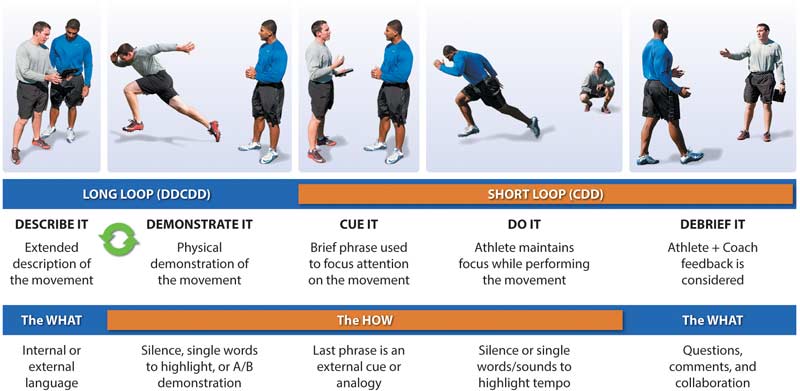
Chapters 8, 9, and 10 provide a peek into Nick’s own coaching language library of external cues and analogies for strength, power, and speed, respectively. While this is a valuable contribution to bring to life all that Nick discusses, if this is all you take away, you will be missing out on the real value of this book. Instead, draw from these examples and apply the numerous strategies and tools outlined throughout the book, and this will allow you to upgrade your language and communication with your athletes in almost any coaching scenario.
Something that has been very cool, and that I haven’t seen before, was the presenting of a The Language of Coaching book club alongside the book’s release. Nick has been hosting a fortnightly Q&A on YouTube, which gives him the opportunity to focus on one section of the book each night and perhaps bring greater life and detail to the information included in the manual. Those book club sessions have been recorded and are available to view here, and they provided those watching live with the opportunity to directly ask the author questions on the material.
Throughout the text, the extent of Nick’s reading and research is readily apparent, and he provides a whole library full of book recommendations for coaches who want to dive deeper into topics, to learn and upskill. Coaches, experts, and thought leaders across many fields annually produce their recommended reading list for the year. I do not think it is too bold of a prediction to state The Language of Coaching will become a fixture on many of these “must read” lists for years to come, alongside many of the existing well-known seminal texts.
Since you’re here…
…we have a small favor to ask. More people are reading SimpliFaster than ever, and each week we bring you compelling content from coaches, sport scientists, and physiotherapists who are devoted to building better athletes. Please take a moment to share the articles on social media, engage the authors with questions and comments below, and link to articles when appropriate if you have a blog or participate on forums of related topics. — SF

